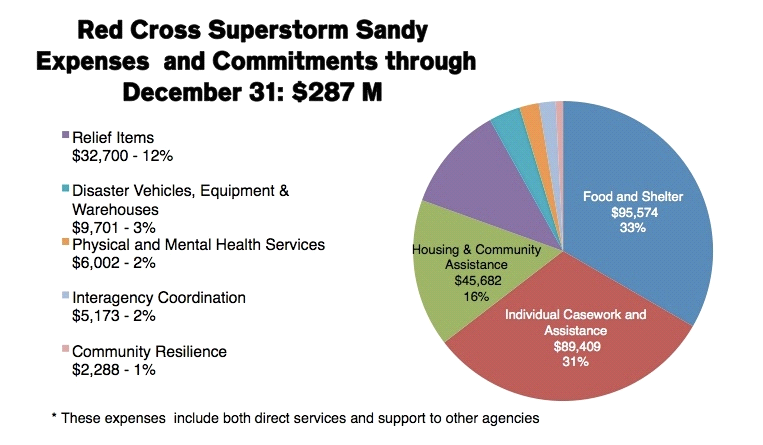Nonprofits Show Heroism in Wake of Sandy
This guest post by The Long Island Community Foundation is the second part of our series on Hurricane Sandy. On October 29, Super Storm Sandy, one of the largest storms ever to hit the United States, made landfall, devastating coastal communities in the tri-state area. Long Island’s infrastructure, landscape, and neighborhoods were severely affected. Over […]
This guest post by The Long Island Community Foundation is the second part of our series on Hurricane Sandy.
On October 29, Super Storm Sandy, one of the largest storms ever to hit the United States, made landfall, devastating coastal communities in the tri-state area. Long Island’s infrastructure, landscape, and neighborhoods were severely affected. Over 90% of the region was left without electricity, with many homes and businesses out for as long as two weeks; transportation systems were flooded and immobile; water sources and homes were polluted by raw sewage and oil; and nearly 100,000 homes and businesses were destroyed or damaged, including 2,000 homes deemed uninhabitable. Long Beach, which is home to 33,000 residents and the area hardest hit on Long Island, suffered more than $200 million in damages, more than any other single area affected by the storm.
It’s with sincere gratitude that we thank our partners — the local nonprofit heroes — many of whom had suffered their own personal and organizational losses, but immediately got to the task of healing families, neighborhoods, and the Island’s most vulnerable.
The Long Island Community Foundation responded by immediately providing nearly $50,000 in grants to local grassroots organizations that were mobilized within hours of Sandy’s aftermath. LICF’s first round of grants were made to Dominican Sisters of Amityville; Five Towns Community Center in Inwood; Long Beach Latino Civic Association, Long Beach Reach and New York Communities for Change in Long Beach; Mastic-Shirley COAD; and Pronto in Bayshore. These emergency grants to some of our hardest hit communities made it possible for local nonprofits to provide essential services such as distribution of food, clothing, supplies, and emergency medical care, help with FEMA registration and relocation services, outreach to Spanish-speaking residents, and mental health services.
Shortly thereafter, and at the request of donors and others throughout the community, LICF established the Super Storm Sandy Long Island Relief and Restoration Fund. Through generous donations, the Fund raised nearly $300,000. We were able to make additional grants to support organizations that focused on volunteer services, legal services, capacity building and collaborative efforts for nonprofits to share information and resources. They are listed below.
- Health and Welfare Council of Long Island, $30,000 for the LI Voluntary Organizations Active in Disaster (LIVOAD)’s Long Term Recovery Group a coalition of nonprofit, government, and for-profit organizations in Nassau and Suffolk counties committed to working together on disaster preparedness, response, and recovery.
- Long Island Volunteer Center, $20,000 to coordinate the response of disaster groups serving LI, training and dispatching volunteers in muck-out teams, hosting training sessions for organizations on worker safety, and hosting group meetings of the LIVOAD; which is providing space for out-of-state groups assisting in rebuilding and distributing protective gear and supplies to organizations assisting in clean up work.
- Hofstra University, Maurice A. Deane School of Law, $25,000 to expand the Disaster Recovery Clinic, created to provide pro-bono legal representation to nonprofits and small businesses struggling with damage and loss.
- Touro College, Jacob D. Fuchsberg Law Center, $20,000 for a free legal clinic to deal with critical legal needs resulting from Super Storm Sandy. Clinic students under faculty supervision will advise, counsel, and litigate in areas such as housing, landlord/tenant disputes, employment, FEMA benefits, property damage and rebuilding, consumer fraud, contractor disputes, and small business issues.
- Vision Long Island, $15,000 for local grassroots organizations in Lindenhurst, Freeport, and Mastic Beach involved in restoration and rebuilding efforts, providing equipment needed for muck-outs and building capacity and infrastructure to ensure long-term viability.
LICF continues to accept donations to the Fund and we will continue to make grants to help rebuilding efforts and strengthen structures and systems so that our region is better prepared for future disasters.
Additionally, the Long Island Community Foundation, Horace and Amy Hagedorn Fund, Rauch Foundation, and New York Community Bank have established the Sandy Building Back Stronger Fund to pool local philanthropic resources and create a joint grant making strategy to support ongoing recovery efforts that:
- build the resiliency of the non-profit sector and strengthen community systems to respond to emergencies;
- provide technical assistance and support to community organizations that are the safety net for communities, families, and the most vulnerable Long Islanders;
- improve sharing and dissemination of information and resources between regional efforts and local neighborhoods and people;
- ensure rebuilding efforts are done in a way that is fair and doesn’t discriminate against vulnerable people.
Special thanks to the New York State Health Foundation for its donation to LICF to assist those organizations working on health-related Sandy issues; and to Newman’s Own Foundation for its grant to The New York Community Trust, a portion of which was designated for use by LICF to fund Long Island nonprofits working to assist in Sandy recovery.
More like this
Hurricane Sandy: The Long Road to Recovery
